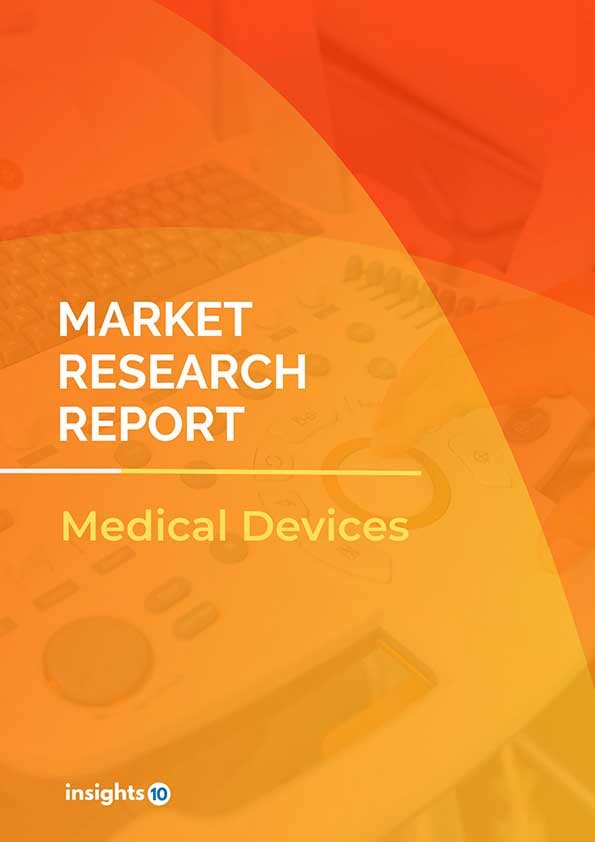US 3D Printing Medical Devices Market Analysis
The US 3D printing medical devices market is projected to grow from $1.2 Bn in 2022 to $3.6 Bn by 2030, registering a CAGR of 14.3% during the forecast period of 2022-30. 3D printing enables medical devices to be customized to the individual patient's needs, which can improve patient outcomes and satisfaction. The US 3D printing medical devices market is highly competitive, with several established players and new entrants vying for market share. Some of the major players in the US 3D printing medical devices market include Stratasys, Stryker Corporation, 3D Systems, and Materialise NV
Buy Now

US 3D Printing Medical Devices Market Executive Summary
According to projections, the US market for 3D-printed medical equipment would increase from $1.2 billion in 2022 to $3.6 billion in 2030, growing at a CAGR of 14.3% during the forecast period of 2022-30.
A fast-expanding area of the medical device business is the US 3D printing medical devices market. Additive manufacturing, also referred to as 3D printing, is the process of making three-dimensional objects by stacking different materials on top of one another. Implants, prosthetic limbs, and surgical instruments have all been produced using 3D printing in the medical device sector.
Many reasons, including the following, drive the US market for 3D-printed medical devices:
The variety of medical devices that may be produced using 3D printing has increased thanks to the introduction of new 3D printing materials and technology.
- Medical device customisation: 3D printing enables medical equipment modification based on specific patient requirements, which may enhance patient outcomes and lower healthcare expenditures
- Shorter Manufacturing Times: 3D printing may speed up the production of medical equipment, enhancing patient access to treatment and cutting down on wait times
- Cost-effectiveness: 3D printing may lower the price of making medical equipment, making healthcare for patients more accessible and inexpensive
The following are some of the major uses of 3D printing in the medical device sector:
- Custom orthopaedic implants, such as hip and knee replacements, are made possible through 3D printing.
- Custom prostheses are made via 3D printing, which may increase patient comfort and functionality.
- Dental Implants: Dental implants and other dental equipment are made via 3D printing.
- Medical devices, such as bone saws and retractors, are produced using 3D printing.
The US market for 3D printed medical products is very competitive, with both long-established companies and recent startups contending for market dominance. Stratasys, Stryker Company, 3D Systems, and Materialise NV are among the significant companies in the US market for medical equipment made using 3D printing technology.
.png)
Market Dynamics
Growth Drivers
Many reasons, including the following, drive the US market for 3D-printed medical devices:
- Improved Personalization and Customization: 3D printing makes it possible to tailor medical equipment to each patient's demands, which may enhance patient happiness and results
- Cost Savings: 3D printing makes it possible to produce medical equipment at a cheaper cost than conventional manufacturing techniques, which may benefit both patients and healthcare providers
- Shorter Time to Market: The ability to quickly prototype and develop medical equipment thanks to 3D printing may shorten the time it takes for new items to reach the market
- Growing Demand for Implants and Prosthetics: 3D printing is ideally suited for producing these kinds of medical devices, which are in high demand due to the ageing US population
- Technological Developments: The potential applications of 3D printing in the medical industry are growing as a result of technological developments in the field, such as the ability to print with a wider variety of materials
- Regulatory Support: Regulatory organisations like the FDA are supporting 3D printing in the medical industry more and more, which is encouraging adoption and investment
Obstacles to the US market for 3D-printed medical devices
The US market for 3D-printed medical equipment is additionally constrained by a number of factors, such as:
- Restricted Reimbursement Policies: The use of 3D printed medical equipment by healthcare providers may be constrained by the lack of well-established reimbursement rules
- Regulatory Challenges: While there is increasing regulatory support for 3D printing in medicine, there are still regulatory issues that need to be resolved, especially with regard to quality control and validation
- Problems with intellectual property Medical device 3D printing can raise issues with intellectual property, especially if the device is protected by a patent or trademark
- Limited Number of Skilled Professionals Available: There may be a scarcity of individuals with the particular knowledge and abilities needed to produce 3D-printed medical products
- Constrained Scalability 3D printing is now best suited for generating low-volume, high-value medical products, which may restrict scalability and profitability for certain firms
- Material Limitations: While the range of materials that can be used in 3D printing is expanding, there are still limitations on the types of materials that can be used for medical devices, particularly for implantable devices
Competitive Landscape
Key Players
The market is a highly competitive market with several key players, including:
- Stratasys Ltd.
- 3D Systems Corporation
- Materialise NV
- EOS GmbH
- SLM Solutions Group AG
- EnvisionTEC
Other notable players in the US 3D printing medical devices market include Renishaw, Oxford Performance Materials, and Arcam AB.
Healthcare Policies and Regulatory Landscape
The US 3D printing medical equipment industry is subject to a number of healthcare rules and regulations. The following are some of the important laws and agencies that regulate the market:
- Food and Drug Administration (FDA): The FDA oversees the design, manufacture, and sale of medical devices in the US, including those made by 3D printing. The organisation has published guidelines on the use of 3D printing in the manufacture of medical devices and has approved a number of them.
- Both Medicaid and Medicare, these publicly funded healthcare programmes provide insurance protection for diagnostic and therapeutic treatments, as well as 3D printed medical products. Some 3D-printed medical devices are eligible for coverage, but reimbursement policies are still being developed.
- The Affordable Care Act (ACA): The ACA has regulations governing medical devices, including those made with 3D printing. The law stipulates specific reporting and tracking requirements as well as the need for safe and effective medical devices.
- The National Institutes of Health (NIH) is a federal organisation that supports and carries out biomedical research. The organisation has contributed to research on 3D printing in the medical industry and has funded the creation of 3D-printed medical products.
- The International Organization for Standardization (ISO): The ISO is a non-governmental organisation that creates global standards for many different industries, including healthcare.
1. Executive Summary
1.1 Device Overview
1.2 Global Scenario
1.3 Country Overview
1.4 Healthcare Scenario in Country
1.5 Regulatory Landscape for Medical Device
1.6 Health Insurance Coverage in Country
1.7 Type of Medical Device
1.8 Recent Developments in the Country
2. Market Size and Forecasting
2.1 Market Size (With Excel and Methodology)
2.2 Market Segmentation (Check all Segments in Segmentation Section)
3. Market Dynamics
3.1 Market Drivers
3.2 Market Restraints
4. Competitive Landscape
4.1 Major Market Share
4.2 Key Company Profile (Check all Companies in the Summary Section)
4.2.1 Company
4.2.1.1 Overview
4.2.1.2 Product Applications and Services
4.2.1.3 Recent Developments
4.2.1.4 Partnerships Ecosystem
4.2.1.5 Financials (Based on Availability)
5. Reimbursement Scenario
5.1 Reimbursement Regulation
5.2 Reimbursement Process for Diagnosis
5.3 Reimbursement Process for Treatment
6. Methodology and Scope
US 3D Printing Medical Devices Market Segmentation
By Component
The US market is divided into three categories based on the component: equipment, materials, and software & services. End customers frequently employ software and services for designing and processing control of 3D-printed medical devices, particularly for bespoke items. The cost-effectiveness, utility, uniformity, and precision given by services for medical device 3D printing, together with a rise in demand for personalized 3D printed medical equipment among hospitals and surgical centers, are driving the market demand for software & surgical guides.
- Equipment
- 3D Printers
- 3D Bioprinters
- Materials
- Plastics
- Thermoplastics
- Photopolymers
- Metals and Metal Alloys
- Biomaterials
- Ceramics
- Paper
- Wax
- Other Materials
- Services & Software
By Application
The US market is divided into surgical guides, surgical tools, tissue-engineered goods, hearing aids, wearable medical devices/implantable medical devices, standard prostheses and implants, custom prosthetics and implants, and other medical devices based on the application. Due to the widespread adoption of 3D printing technology in the production of prosthetics and implants, the increased availability of high-quality biomaterials and ceramics for 3D printing, and ongoing industry investment in the development of novel 3D printers, the custom prosthetics and implants segment is expected to hold a larger share of the market in 2022.
- Surgical Guides
- Dental Guides
- Craniomaxillofacial Guides
- Orthopedic Guides
- Spinal Guides
- Surgical Instruments
- Surgical Fasteners
- Scalpels
- Retractors
- Standard Prosthetics & Implants
- Orthopedic Implants
- Dental Prosthetics & Implants
- Craniomaxillofacial Implants
- Bone & Cartilage Scaffolds
- Ligament & Tendon Scaffolds
- Custom Prosthetics & Implants
- Tissue-engineered Products
- Hearing Aids
- Wearable Medical Devices
- Other Applications
By Technology
According to technology, the global market has been divided into three categories: three-dimensional printing (3DP) or adhesion bonding; electron beam melting (EBM); laser beam melting (LBM); photopolymerization; droplet deposition or extrusion-based technologies; and other technologies. The laser beam melting (LBM) segment is anticipated to hold the greatest market share in 2022, in large part due to the growing use of this technology in the dental sector and for the production of implants for minimally invasive surgery.
- Laser Beam Melting
- Direct Metal Laser Sintering
- Selective Laser Sintering
- Selective Laser Melting
- LaserCUSING
- Photopolymerization
- Digital Light Processing
- Stereolithography
- Two-photon Polymerization
- PolyJet 3D Printing
- Fused Deposition Modeling
- Multiphase Jet Solidification
- Low-temperature Deposition Manufacturing
- Microextrusion Bioprinting
- Droplet Deposition/Extrusion-based Technologies
- Electron Beam Melting
- Three-dimensional Printing/Adhesion Bonding/Binder Jetting
- Other Technologies
By End User
The US market has been divided into hospitals and surgical facilities, dental and orthopedic clinics, academic institutions and research labs, pharma-biotech and medical device firms, and clinical research organizations based on end users. In 2022, hospitals and surgical centers are anticipated to hold the greatest market share. The high proportion of this market may be due to the ongoing expansion of internal 3D printing capabilities, the expansion of existing 3D printing laboratories, the rising affordability of 3D printing services, and the quick uptake of cutting-edge technology by hospitals in developed markets.
- Hospitals & Surgical Centers
- Dental & Orthopedic Clinics
- Academic Institutions & Research Laboratories
- Pharma-Biotech & Medical Device Companies
- Clinical Research Organizations
Methodology for Database Creation
Our database offers a comprehensive list of healthcare centers, meticulously curated to provide detailed information on a wide range of specialties and services. It includes top-tier hospitals, clinics, and diagnostic facilities across 30 countries and 24 specialties, ensuring users can find the healthcare services they need.
Additionally, we provide a comprehensive list of Key Opinion Leaders (KOLs) based on your requirements. Our curated list captures various crucial aspects of the KOLs, offering more than just general information. Whether you're looking to boost brand awareness, drive engagement, or launch a new product, our extensive list of KOLs ensures you have the right experts by your side. Covering 30 countries and 36 specialties, our database guarantees access to the best KOLs in the healthcare industry, supporting strategic decisions and enhancing your initiatives.
How Do We Get It?
Our database is created and maintained through a combination of secondary and primary research methodologies.
1. Secondary Research
With many years of experience in the healthcare field, we have our own rich proprietary data from various past projects. This historical data serves as the foundation for our database. Our continuous process of gathering data involves:
- Analyzing historical proprietary data collected from multiple projects.
- Regularly updating our existing data sets with new findings and trends.
- Ensuring data consistency and accuracy through rigorous validation processes.
With extensive experience in the field, we have developed a proprietary GenAI-based technology that is uniquely tailored to our organization. This advanced technology enables us to scan a wide array of relevant information sources across the internet. Our data-gathering process includes:
- Searching through academic conferences, published research, citations, and social media platforms
- Collecting and compiling diverse data to build a comprehensive and detailed database
- Continuously updating our database with new information to ensure its relevance and accuracy
2. Primary Research
To complement and validate our secondary data, we engage in primary research through local tie-ups and partnerships. This process involves:
- Collaborating with local healthcare providers, hospitals, and clinics to gather real-time data.
- Conducting surveys, interviews, and field studies to collect fresh data directly from the source.
- Continuously refreshing our database to ensure that the information remains current and reliable.
- Validating secondary data through cross-referencing with primary data to ensure accuracy and relevance.
Combining Secondary and Primary Research
By integrating both secondary and primary research methodologies, we ensure that our database is comprehensive, accurate, and up-to-date. The combined process involves:
- Merging historical data from secondary research with real-time data from primary research.
- Conducting thorough data validation and cleansing to remove inconsistencies and errors.
- Organizing data into a structured format that is easily accessible and usable for various applications.
- Continuously monitoring and updating the database to reflect the latest developments and trends in the healthcare field.
Through this meticulous process, we create a final database tailored to each region and domain within the healthcare industry. This approach ensures that our clients receive reliable and relevant data, empowering them to make informed decisions and drive innovation in their respective fields.
To request a free sample copy of this report, please complete the form below.
We value your inquiry and offer free customization with every report to fulfil your exact research needs.









































